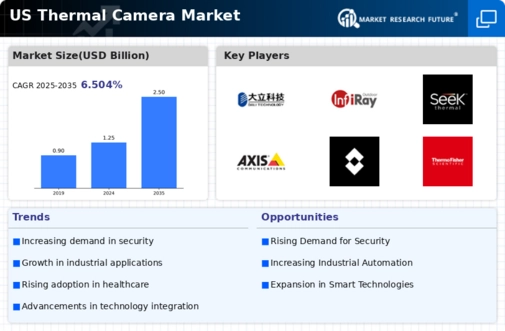Increased Government Investments
Government investments in advanced surveillance and monitoring technologies are significantly impacting the thermal camera market. Various federal and state agencies are allocating funds to enhance public safety and emergency response capabilities. This trend is particularly evident in law enforcement and disaster management sectors, where thermal cameras are being integrated into operational protocols. Recent reports suggest that government spending in this area could increase by 15% annually, thereby providing a substantial boost to the thermal camera market. Such investments are likely to foster innovation and drive the adoption of thermal imaging technologies.
Expansion in Healthcare Utilization
The healthcare sector is witnessing a significant expansion in the use of thermal cameras, particularly for non-invasive diagnostics and patient monitoring. Thermal imaging technology is being employed to detect fevers, monitor blood flow, and assess inflammation. This trend is likely to propel the thermal camera market, as healthcare facilities increasingly adopt these devices for enhanced patient care. Recent estimates suggest that the healthcare segment could represent around 25% of the thermal camera market by 2026. The integration of thermal cameras into telemedicine practices further underscores their growing importance in modern healthcare.
Rising Focus on Safety and Security
The thermal camera market is benefiting from an escalating emphasis on safety and security across various sectors, including public safety, transportation, and critical infrastructure. Organizations are increasingly deploying thermal cameras for surveillance, perimeter security, and threat detection. This heightened focus is driven by the need to mitigate risks and enhance situational awareness. Market data indicates that the security segment is expected to grow at a CAGR of approximately 10% over the next five years. The ability of thermal cameras to operate effectively in low-light conditions makes them a preferred choice for security applications.
Growing Demand in Industrial Applications
The thermal camera market is experiencing a notable surge in demand within industrial sectors, particularly in manufacturing and maintenance. Industries are increasingly utilizing thermal cameras for predictive maintenance, quality control, and process optimization. This trend is driven by the need to enhance operational efficiency and reduce downtime. According to recent data, the industrial segment is projected to account for approximately 35% of the overall market share by 2026. The ability of thermal cameras to detect heat anomalies and prevent equipment failures is becoming indispensable, thereby solidifying their role in the thermal camera market.
Advancements in Miniaturization and Affordability
The thermal camera market is witnessing advancements in miniaturization and affordability, making these devices more accessible to a broader range of consumers and industries. Technological innovations have led to the development of compact thermal cameras that maintain high performance while reducing costs. This trend is likely to expand the market reach, as smaller businesses and individual users can now invest in thermal imaging solutions. Market analysis indicates that the average price of thermal cameras has decreased by approximately 20% over the past few years, which could further stimulate growth in the thermal camera market.




















Leave a Comment